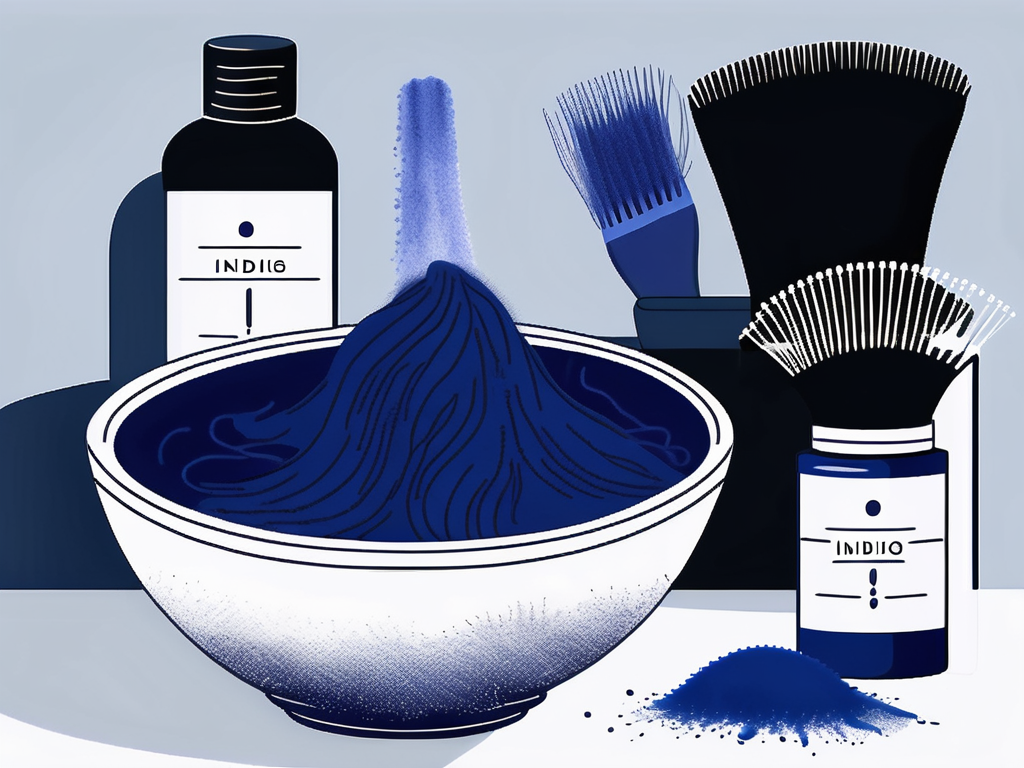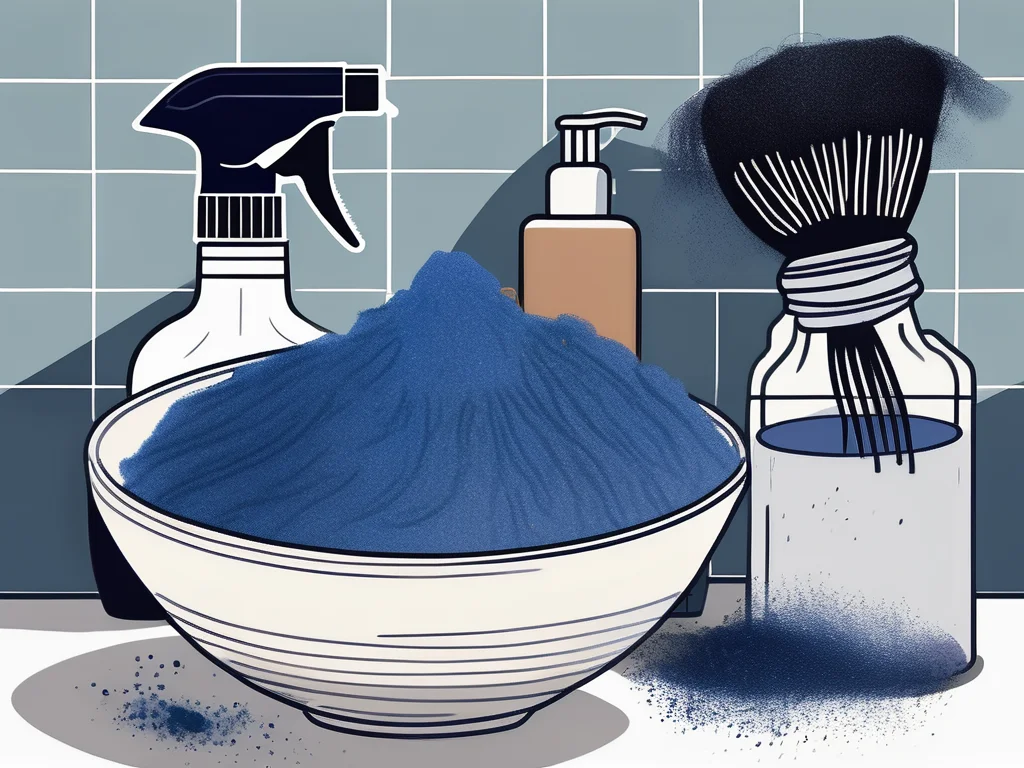Indigo powder is a natural hair dye that has gained popularity in recent years due to its numerous benefits for the hair. In this article, we will explore what indigo powder is, how it works, and the key benefits of using it on your hair. We will also provide a step-by-step guide on how to prepare your hair for indigo powder treatment and tips and tricks for achieving the best results. Lastly, we will address common questions and concerns about indigo powder for hair.
Understanding Indigo Powder and Its Benefits for Hair
What is Indigo Powder?
Indigo powder is derived from the leaves of the indigo plant, scientifically known as Indigofera tinctoria. It has been used for centuries as a natural dye, particularly in traditional hair care practices. It is known for its deep blue color, which can vary depending on the processing and the mixing of other ingredients.
The Science Behind Indigo Powder for Hair
When indigo powder is combined with henna powder, it creates a chemical reaction that results in various shades of brown and black. This reaction occurs due to the lawsone molecule present in henna powder, which binds to the hair shaft when activated. Indigo powder acts as a catalyst, facilitating the binding process and enhancing the color payout.
Additionally, indigo powder contains natural conditioning agents that promote hair health and add shine. It can help repair and strengthen damaged hair, making it a popular choice for those seeking a natural alternative to chemical hair dyes.
Key Benefits of Using Indigo Powder on Hair
1. Natural and Chemical-Free: Indigo powder is free from harsh chemicals, such as ammonia and peroxide, commonly found in commercial hair dyes. It offers a safer option for those with sensitive scalps or allergies.
2. Long-Lasting Color: Indigo powder provides a rich and vibrant color that can last for several weeks. It offers excellent coverage for gray hair, making it an ideal choice for individuals looking to achieve a natural, youthful appearance.
3. Conditions and Nourishes: Indigo powder has inherent moisturizing properties that can improve hair texture and restore shine. It nourishes the hair follicles, reducing frizz and promoting overall hair health.
4. Blend of Colors: By mixing indigo powder with henna or other natural hair dyes, you can create a range of shades that complement your skin tone and personal style.
But that’s not all! Indigo powder has even more benefits for your hair. One of its lesser-known advantages is its ability to promote hair growth. The natural compounds found in indigo powder stimulate the hair follicles, encouraging new hair growth and preventing hair loss. So not only will you achieve beautiful color, but you’ll also be giving your hair a boost in volume and thickness.
Furthermore, indigo powder is a great option for those who are looking to cover up stubborn grays. Its intense pigmentation effectively conceals gray hair, providing a seamless blend with your natural color. Say goodbye to those pesky grays and hello to a youthful, vibrant mane!
Another interesting fact about indigo powder is its versatility. While it is commonly used as a hair dye, it can also be utilized for other purposes. For example, indigo powder can be mixed with oils or other natural ingredients to create a nourishing hair mask. This mask can help treat dry and damaged hair, restoring its vitality and luster.
So, whether you’re seeking a chemical-free hair dye, a solution for gray coverage, or a way to promote hair growth, indigo powder has got you covered. With its numerous benefits and natural properties, it’s no wonder that indigo powder has stood the test of time as a trusted hair care ingredient.
Preparing Your Hair for Indigo Powder Treatment
Assessing Your Hair Type and Condition
Before applying indigo powder, it is essential to assess your hair type and condition. This step will help determine the appropriate ratio of indigo powder to henna powder or other ingredients. If you have previously dyed or chemically treated hair, it is recommended to perform a strand test to ensure compatibility and desired results.
Understanding your hair type is crucial in achieving the desired outcome when using indigo powder. Fine hair may require a different application technique compared to thick or coarse hair. Additionally, porous hair may absorb the dye more quickly, resulting in a darker shade, while less porous hair may need a longer processing time.
Essential Pre-Treatment Steps
Prior to applying indigo powder, there are a few pre-treatment steps that will help optimize the color and longevity of the dye.
- Wash your hair thoroughly to remove any product buildup, oils, or dirt that may hinder the dye’s absorption.
- Deep condition your hair to restore moisture and prepare it for the dyeing process.
- If using henna powder, prepare the henna paste and allow it to rest for a few hours (preferably overnight) to activate the dye release.
Another essential pre-treatment step is to clarify your hair using a clarifying shampoo to remove any residue from styling products or hard water minerals. This will ensure that the indigo powder can penetrate the hair shaft evenly, resulting in a more uniform color.
Step-by-Step Guide to Applying Indigo Powder
Mixing Indigo Powder for Hair Use
To achieve the desired color, indigo powder needs to be mixed with henna powder or other ingredients in the right proportions. Follow these steps:
- In a bowl, combine the desired amount of indigo powder with henna powder or a henna-indigo mix.
- Add warm water gradually to the mixture, stirring continuously until you achieve a smooth, yogurt-like consistency.
- Let the mixture sit for approximately 10-15 minutes to allow the dye to release.
Application Process for Best Results
Now that your indigo paste is ready, it’s time to apply it to your hair:
- Divide your hair into sections for easy application.
- Start applying the mixture from the roots to the tips, ensuring even coverage.
- Once applied, cover your hair with a shower cap and leave the indigo paste on for the recommended time (typically 1-2 hours).
- Rinse your hair thoroughly with lukewarm water until the water runs clear. Avoid using shampoo for at least 24 hours to allow the indigo color to develop fully.
Post-Application Care and Maintenance
After the indigo treatment, it is vital to give your hair the necessary care to maintain the color and enhance its health:
- Use sulfate-free shampoo and conditioner to avoid stripping the color and drying out the hair.
- Apply a deep conditioning treatment regularly to keep your hair hydrated and nourished.
- Avoid excessive heat styling and use heat protectants when using styling tools.
Additionally, it is important to note that indigo powder can have a cumulative effect on the hair. This means that with each application, the color intensity may deepen. If you desire a lighter shade, it is recommended to start with a smaller amount of indigo powder and gradually increase it with subsequent applications until you achieve the desired color.
Furthermore, the timing of the indigo paste application is crucial. Leaving the paste on for too long may result in a darker color than intended, while rinsing it off too soon may lead to a lighter shade. You should follow the recommended time in the instructions or consult a professional hair colorist for personalized advice.
Tips and Tricks for Using Indigo Powder
Maximizing the Benefits of Indigo Powder
To maximize the benefits of indigo powder, consider the following tips:

- Perform regular henna or indigo treatments to maintain the color intensity and ensure even coverage.
- Mix indigo powder with other natural ingredients like amla or fenugreek powder to further enhance the conditioning effects and improve hair growth.
- Experiment with different ratios of indigo powder and henna powder to achieve your desired shade.
Common Mistakes to Avoid
While using indigo powder for hair, it is essential to avoid the following mistakes:
- Not conducting a strand test to determine compatibility and expected results.
- Leaving the indigo paste on for too long, resulting in an overly dark color.
- Applying indigo directly on chemically treated or relaxed hair without proper consultation or expert guidance.
Frequently Asked Questions about Indigo Powder for Hair
Can Indigo Powder be Used on All Hair Types?
Yes. All hair types can use indigo powder. However, the result may vary depending on the starting hair color and texture. You should perform a strand test or seek professional advice if you’re uncertain about the outcome.
How Often Should You Use Indigo Powder?
The frequency of indigo powder usage depends on individual preferences and hair growth rate. On average, most people choose to apply indigo powder every 3-4 weeks to maintain the color intensity. Listen to your hair’s needs and avoid excessive dyeing to prevent dryness caused by overdoing the process.
Is Indigo Powder Safe for Hair?
In its pure and natural form, indigo powder is safe for hair and effectively used for hair care. Before using indigo powder, individuals with allergies should do a patch test to ensure no adverse reactions occur. Additionally, it is important to purchase indigo powder from reputable sources to ensure its purity and authenticity.
In conclusion, indigo powder offers a natural and chemical-free alternative to traditional hair dyes. Understand hair properties, prep hair, apply correctly for vibrant color and hair health. Strand test, seek advice, post-treatment care essential.




